 |
||
|
HOME
|
US Navy -
ships
|
US Navy - air
units
|
USMC - air
units
|
International
Navies
|
Weapon Systems
|
Special Reports |
||
|
US Navy - Guided Missile Destroyer DDG 82 - USS Lassen |
||
|
||
| 09/24 | ||
|
Type,
class: Guided Missile Destroyer - DDG; Arleigh Burke
class, Flight IIA Builder: Ingalls Shipbuilding, Pascagoula, Mississippi, USA STATUS: Awarded: January 6, 1995 Laid down: August 24, 1998 Launched: October 16, 1999 Commissioned: April 21, 2001 IN SERVICE Homeport: Naval Station Mayport, Florida Namesake: Commander Clyde Everett Lassen (1942-1994) Ships Motto: FROM COURAGE LIFE Technical Data: see: INFO > Arleigh Burke class Guided Missile Destroyer - DDG |
||
| images | ||
 Naval Station Mayport, Florida - August 2024 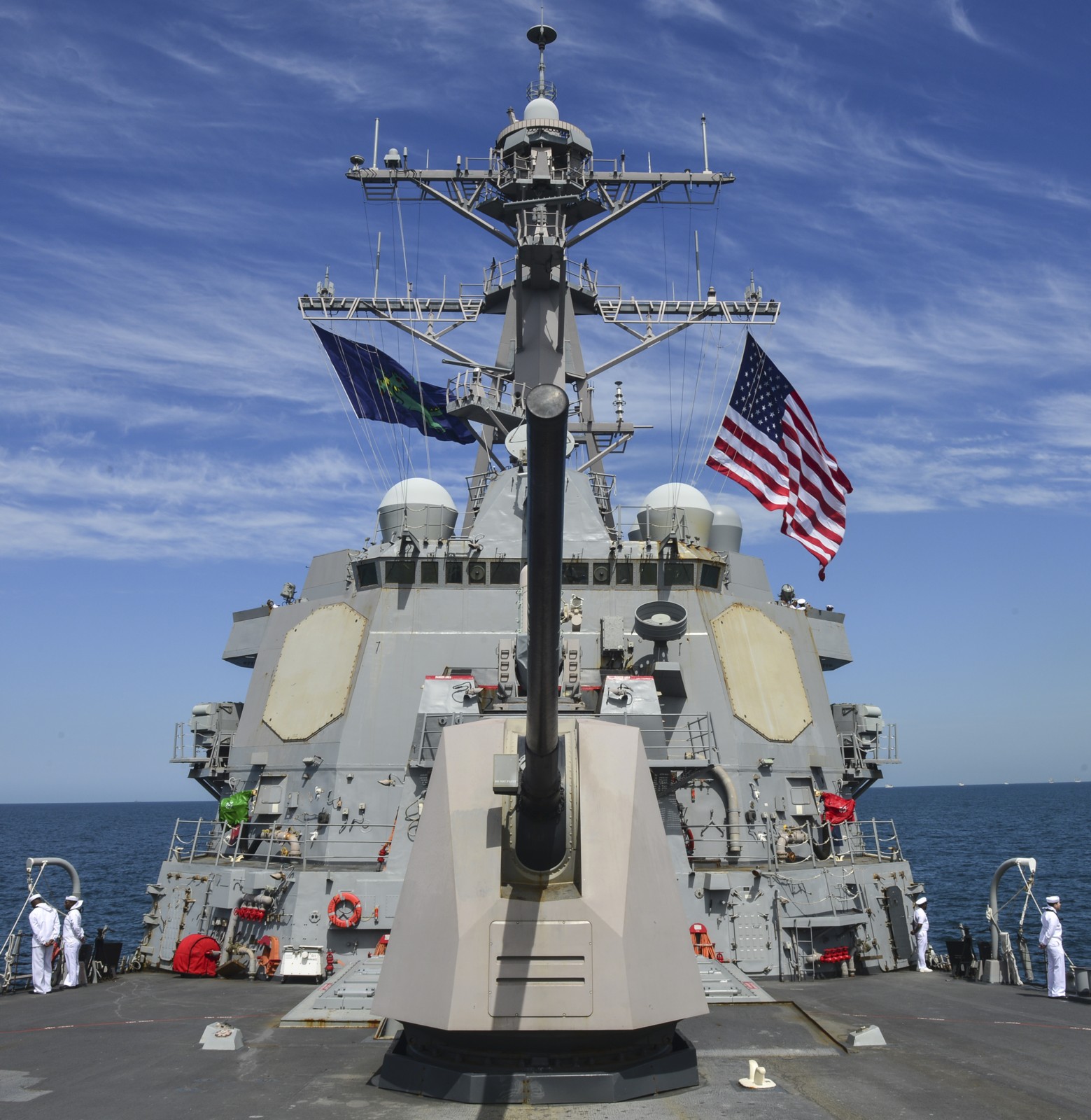 off Rio de Janeiro, Brazil - Exercise UNITAS LXIII - September 2022 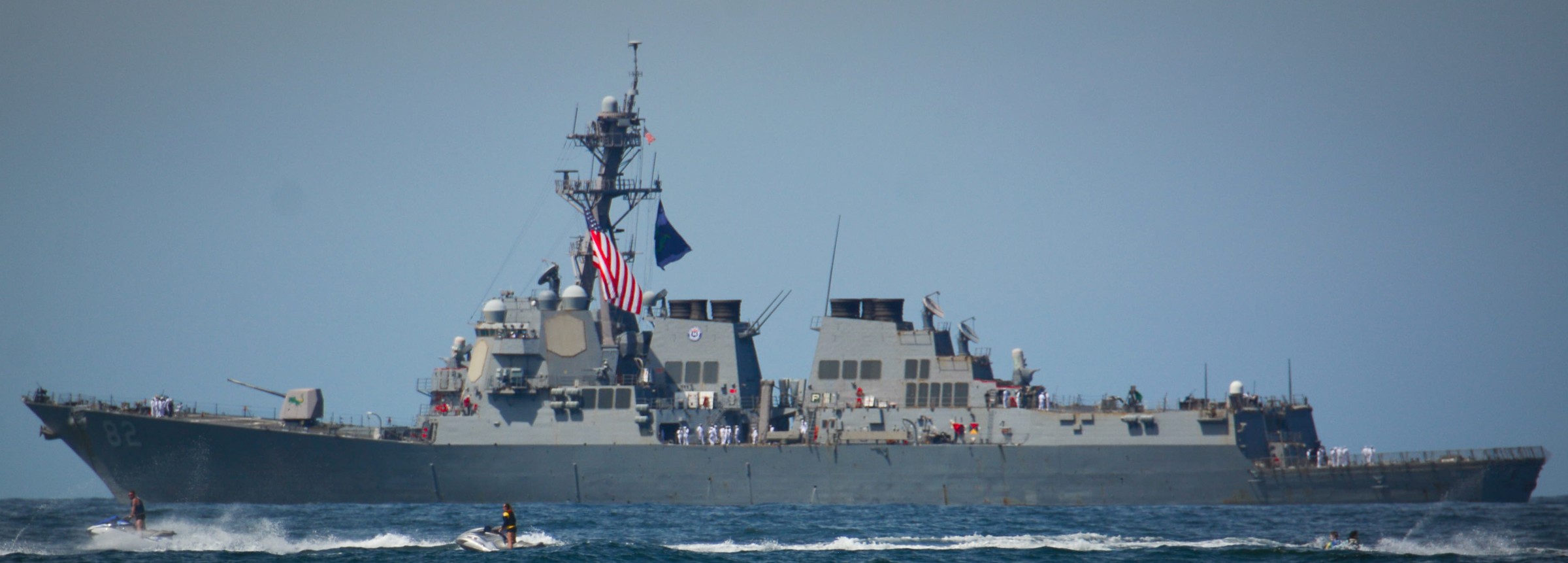 off Rio de Janeiro, Brazil - Exercise UNITAS LXIII - September 2022 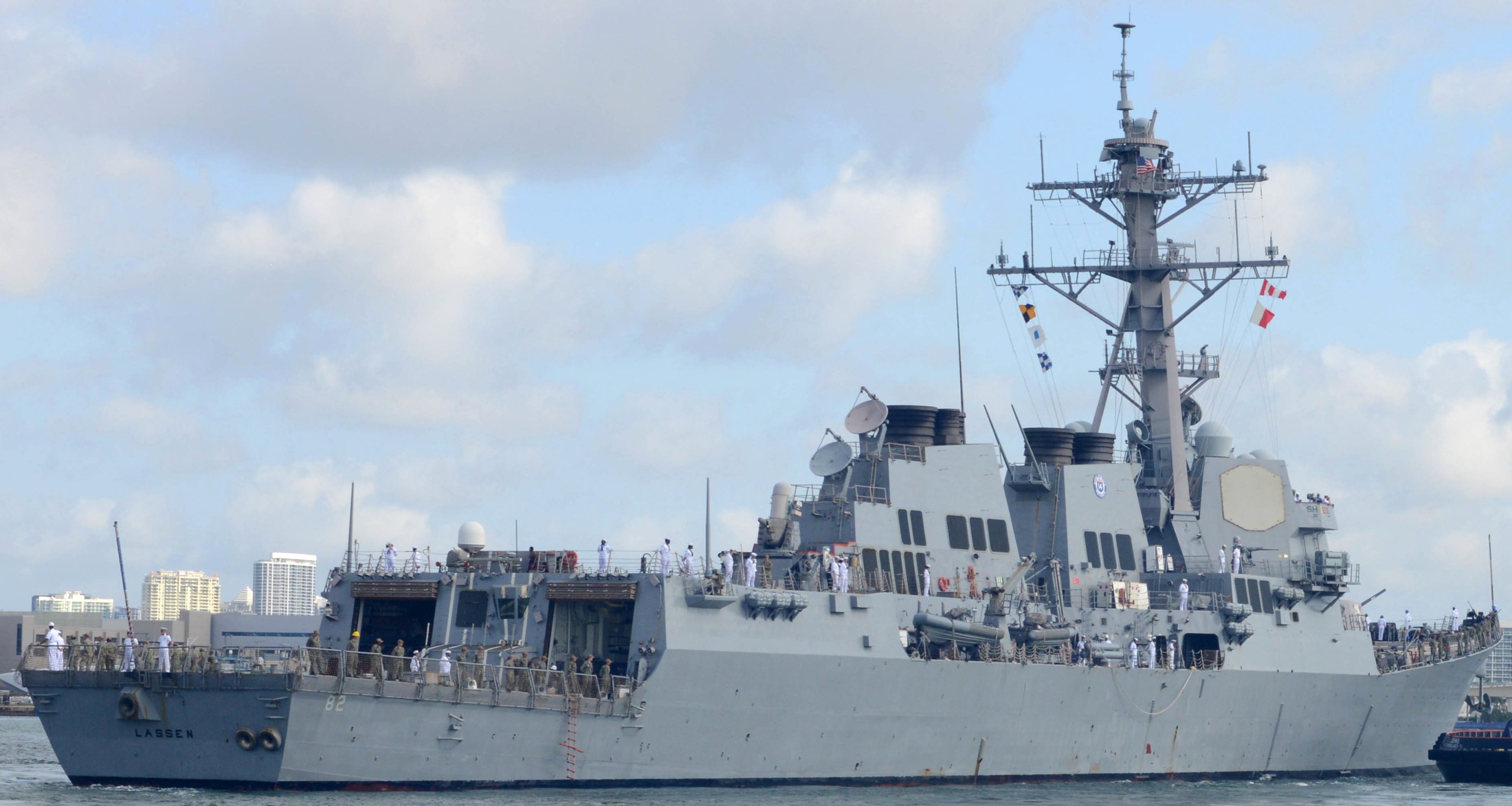 departing Port Everglades, Florida after Fleet Week - May 8, 2022 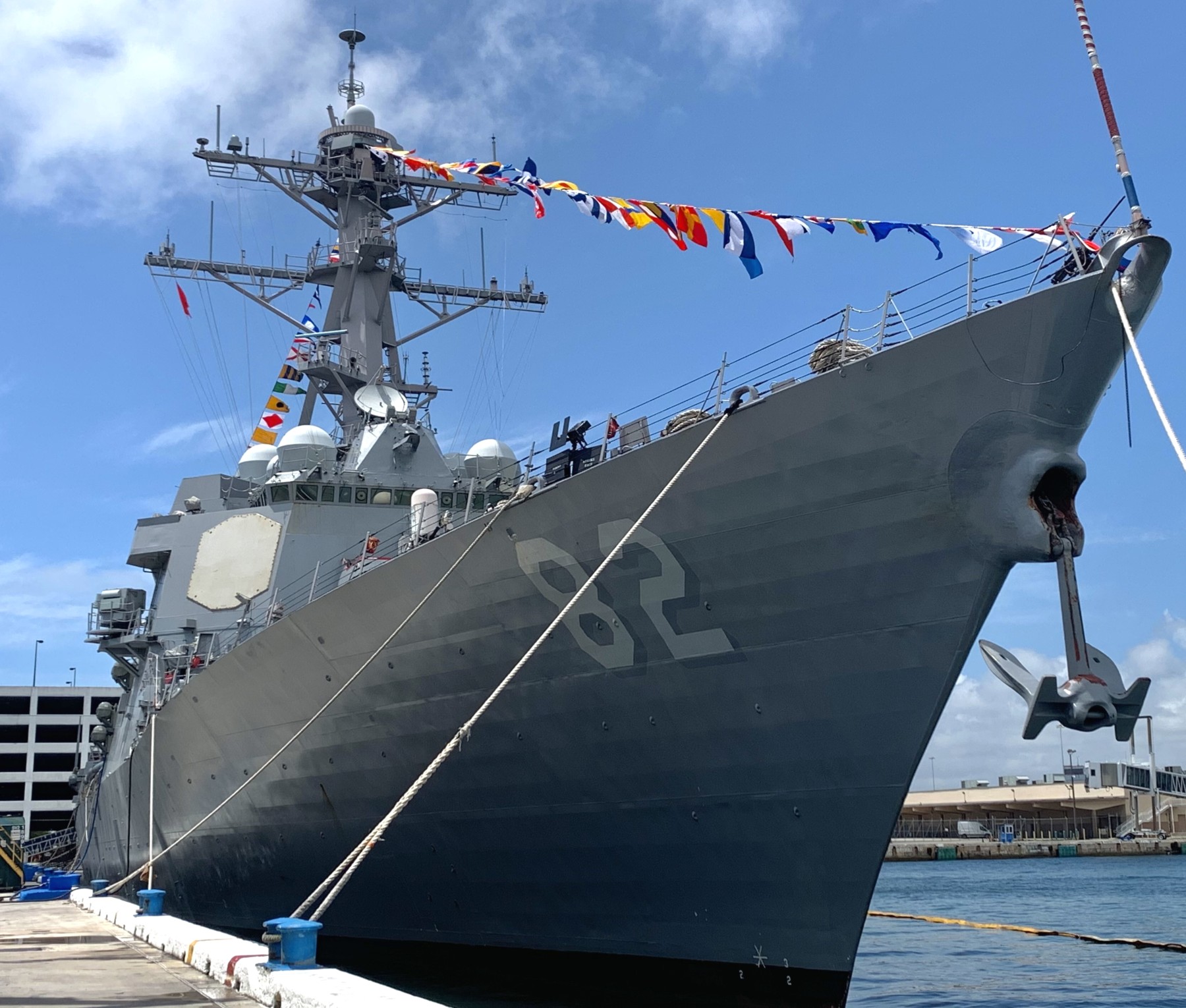 Fleet Week Port Everglades, Florida - May 2022 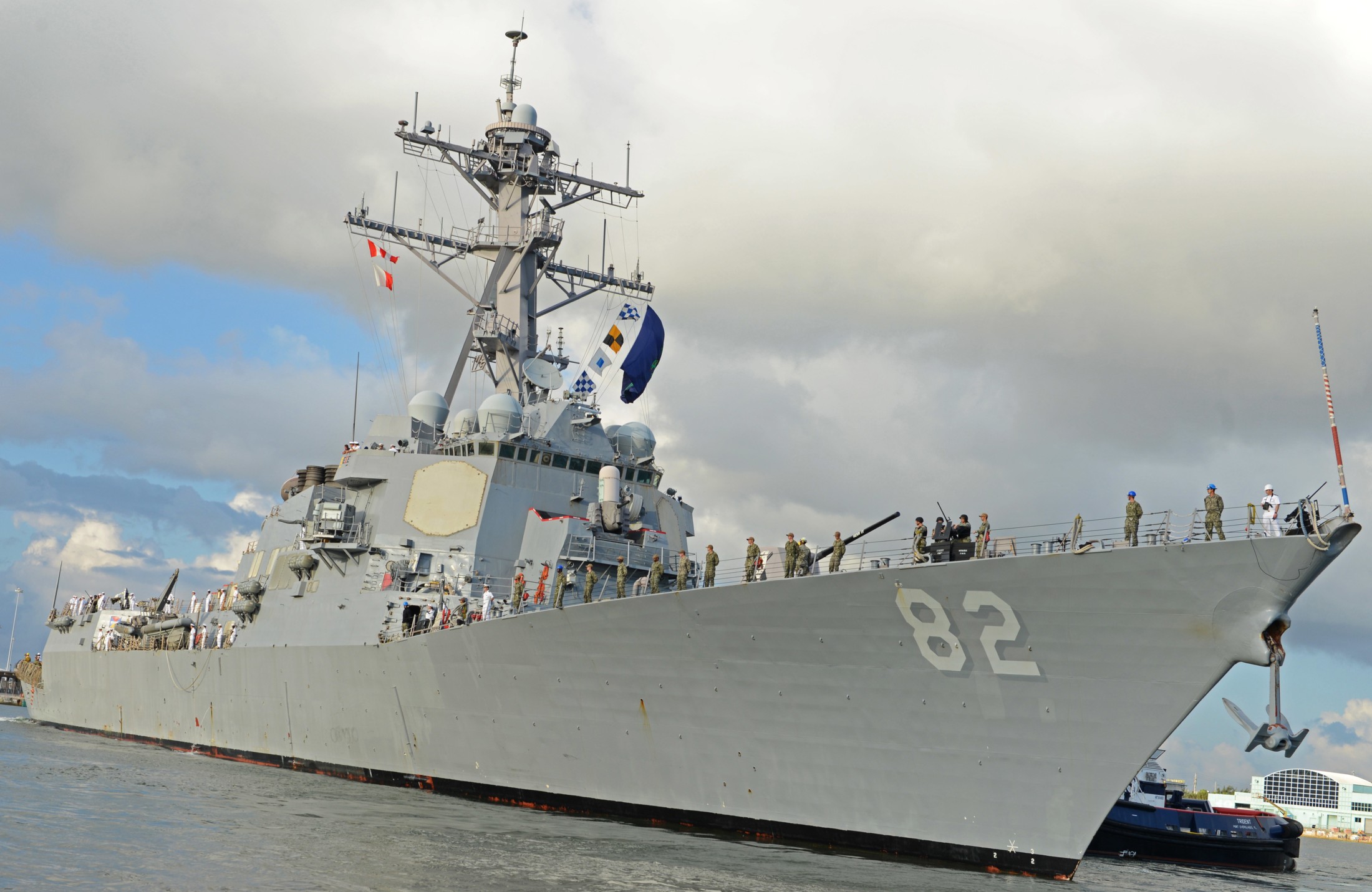 arriving in Port Everglades, Florida for Fleet Week - May 1, 2022 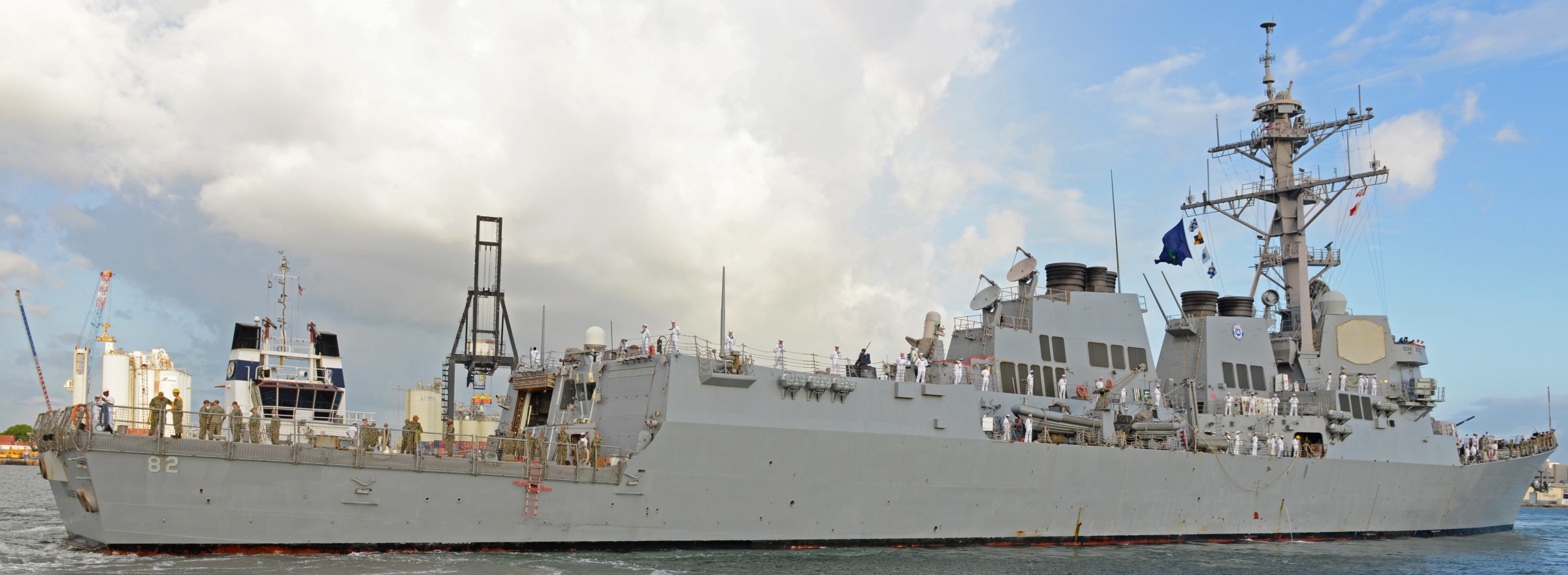 arriving in Port Everglades, Florida for Fleet Week - May 1, 2022 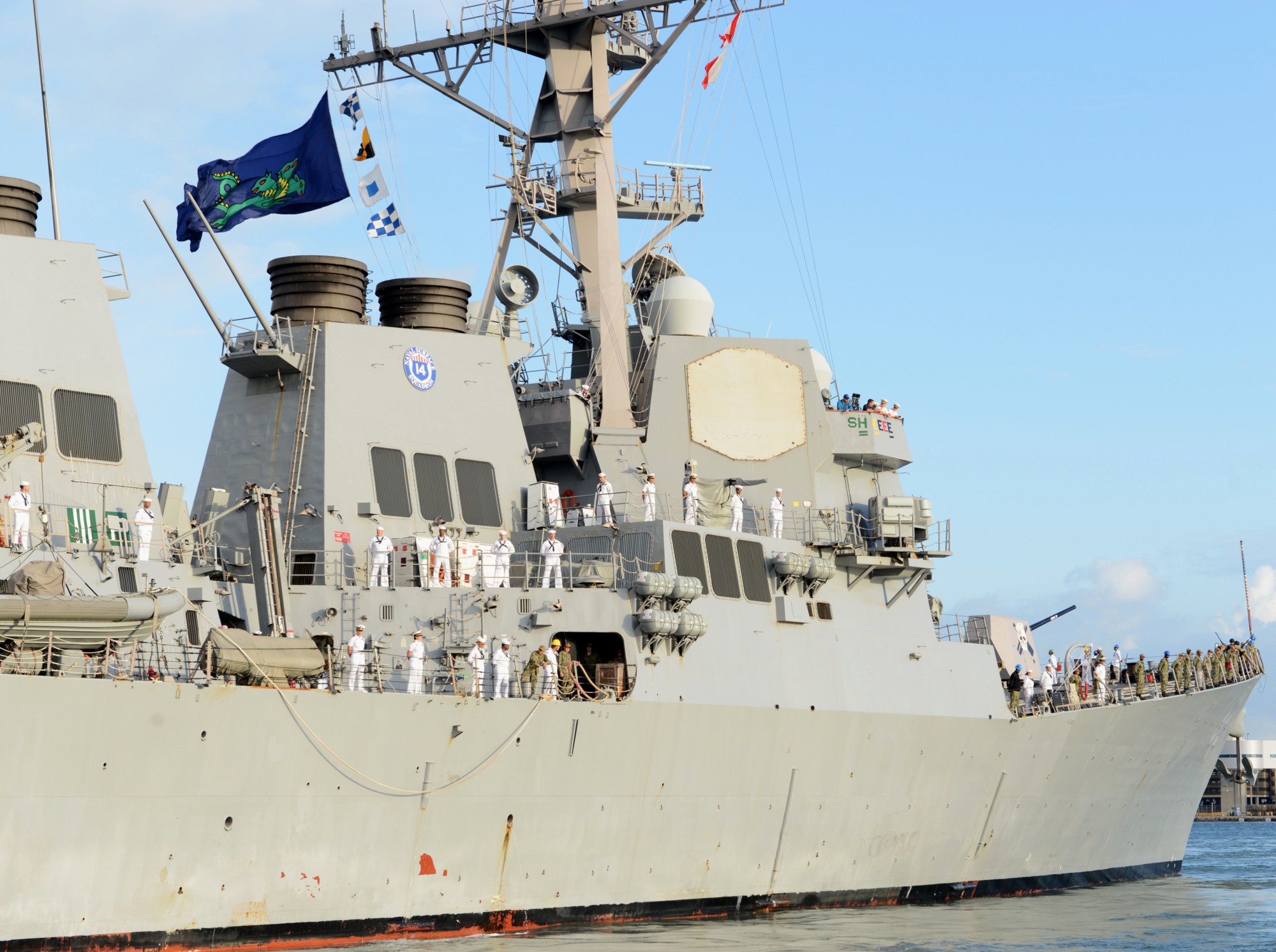 arriving in Port Everglades, Florida for Fleet Week - May 1, 2022 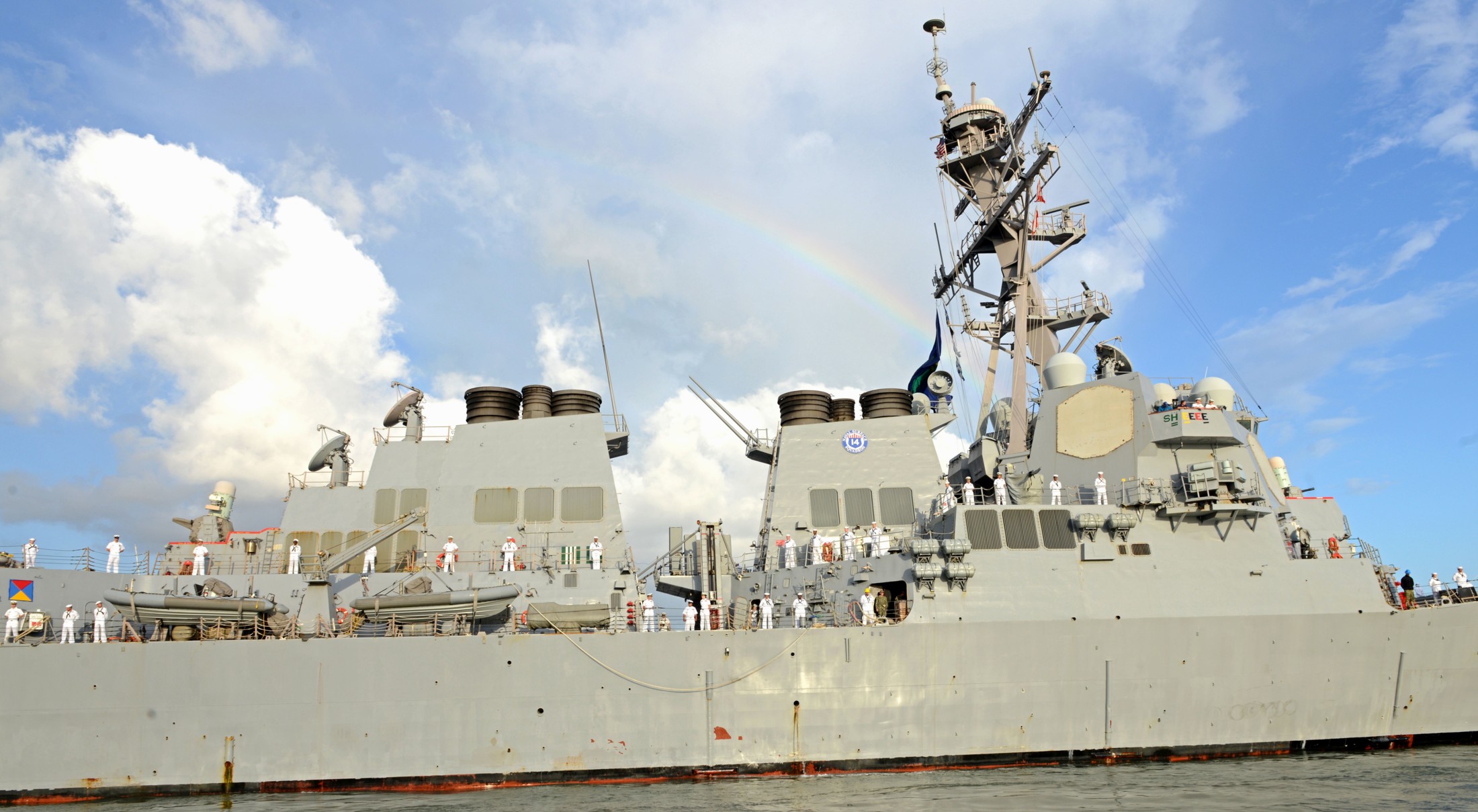 arriving in Port Everglades, Florida for Fleet Week - May 1, 2022 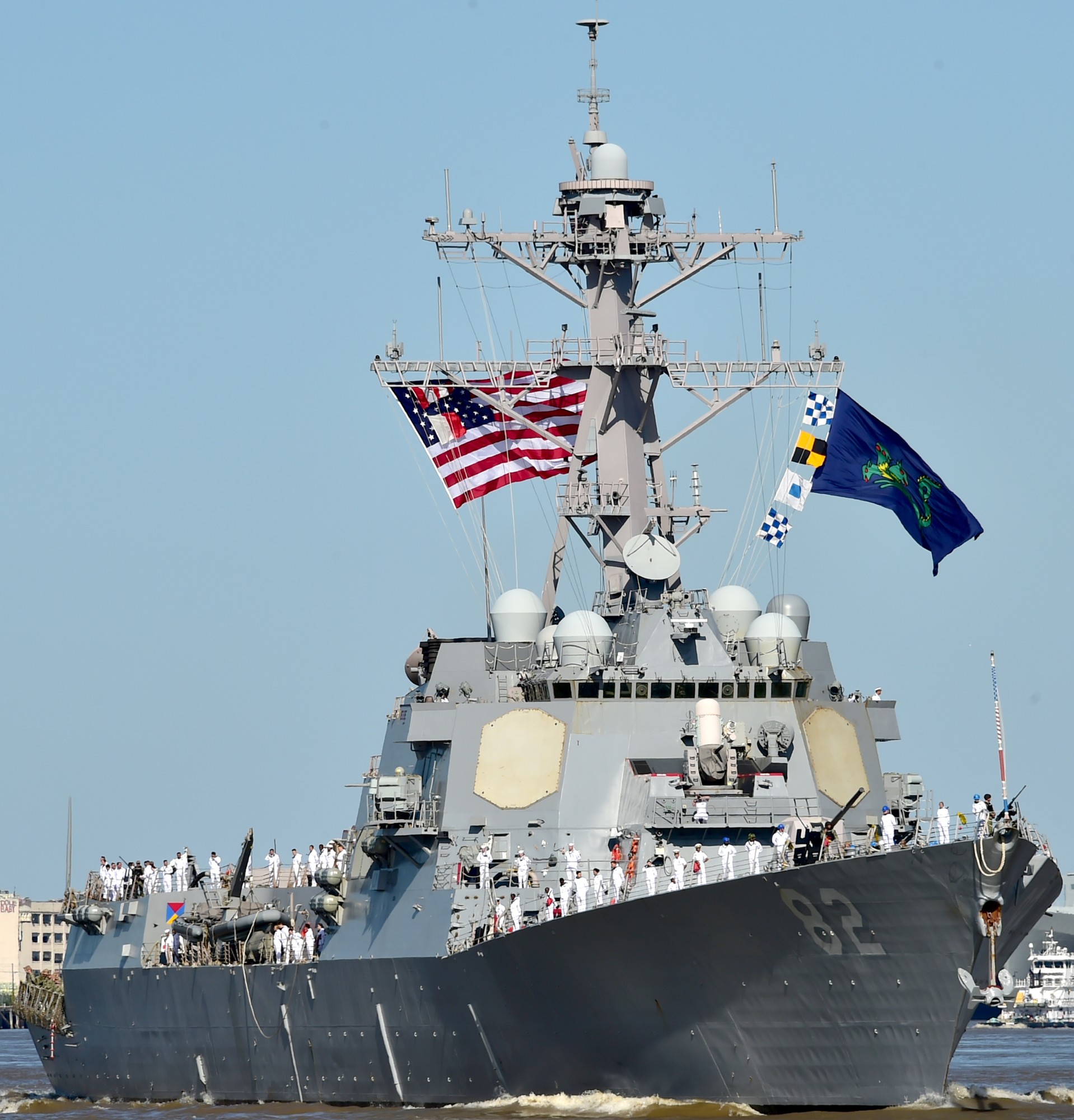 Navy Week New Orleans, Louisiana - April 2022 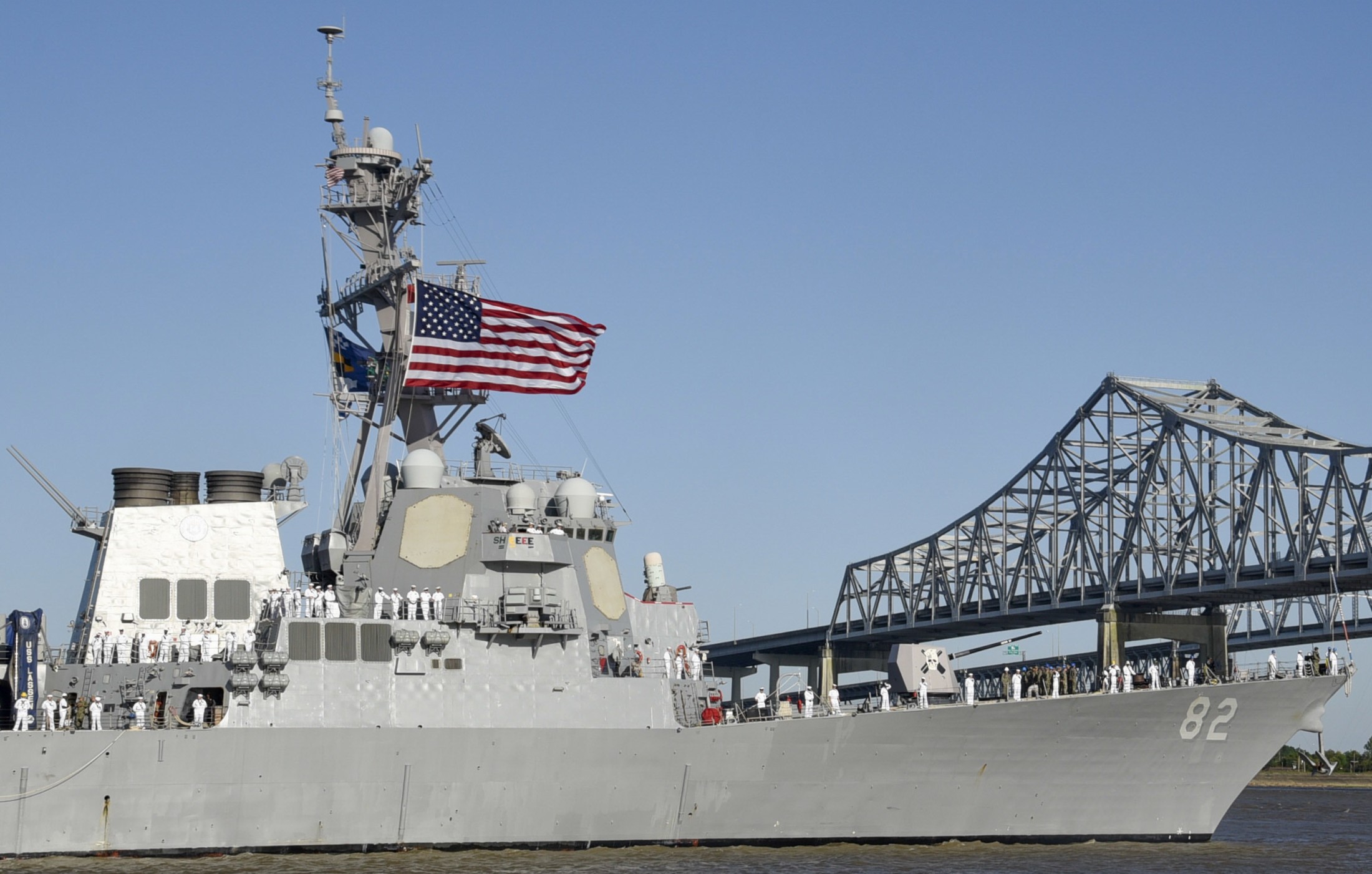 Navy Week New Orleans, Louisiana - April 2022  Atlantic Ocean - June 2021 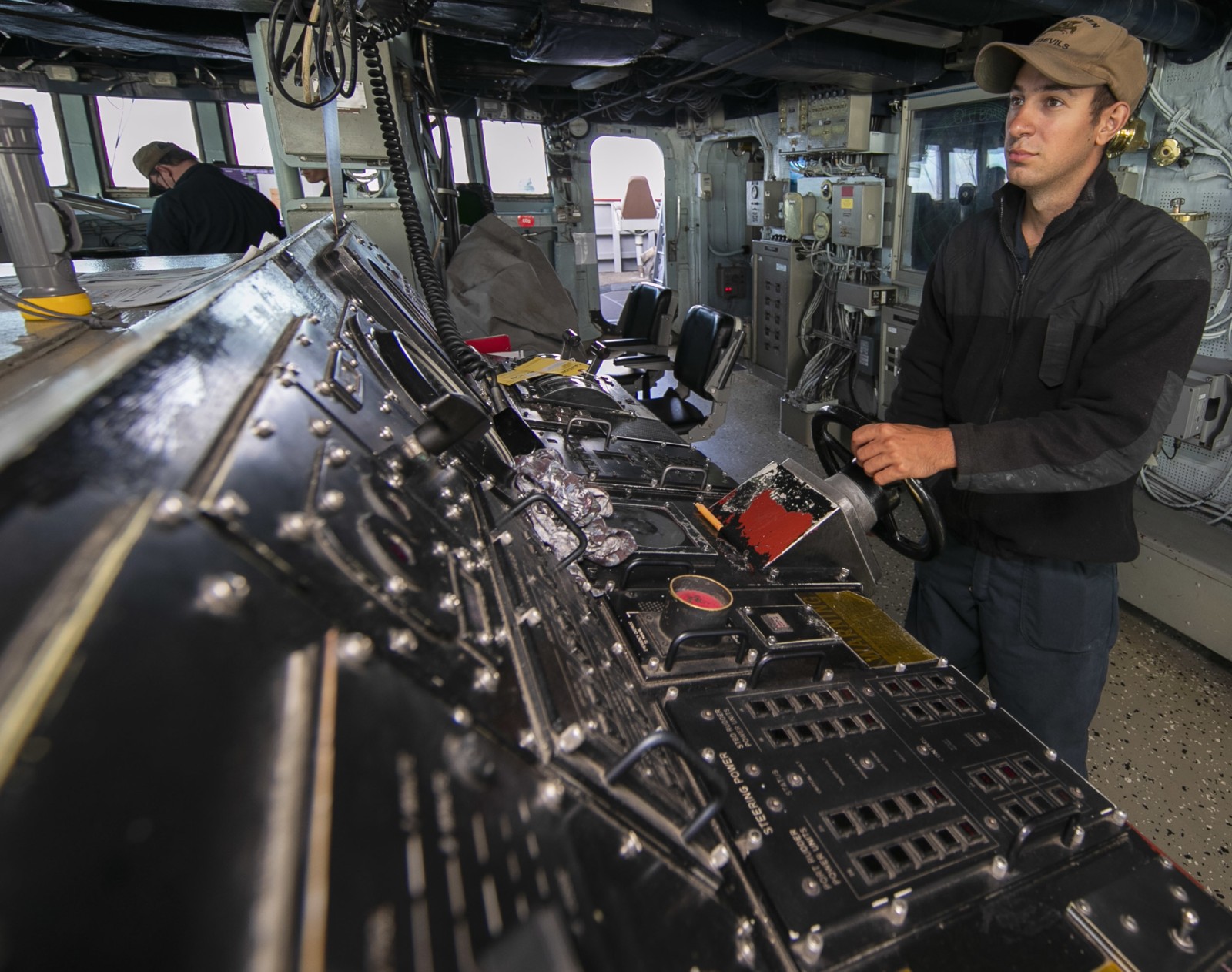 bridge/helm - Atlantic Ocean - June 2021 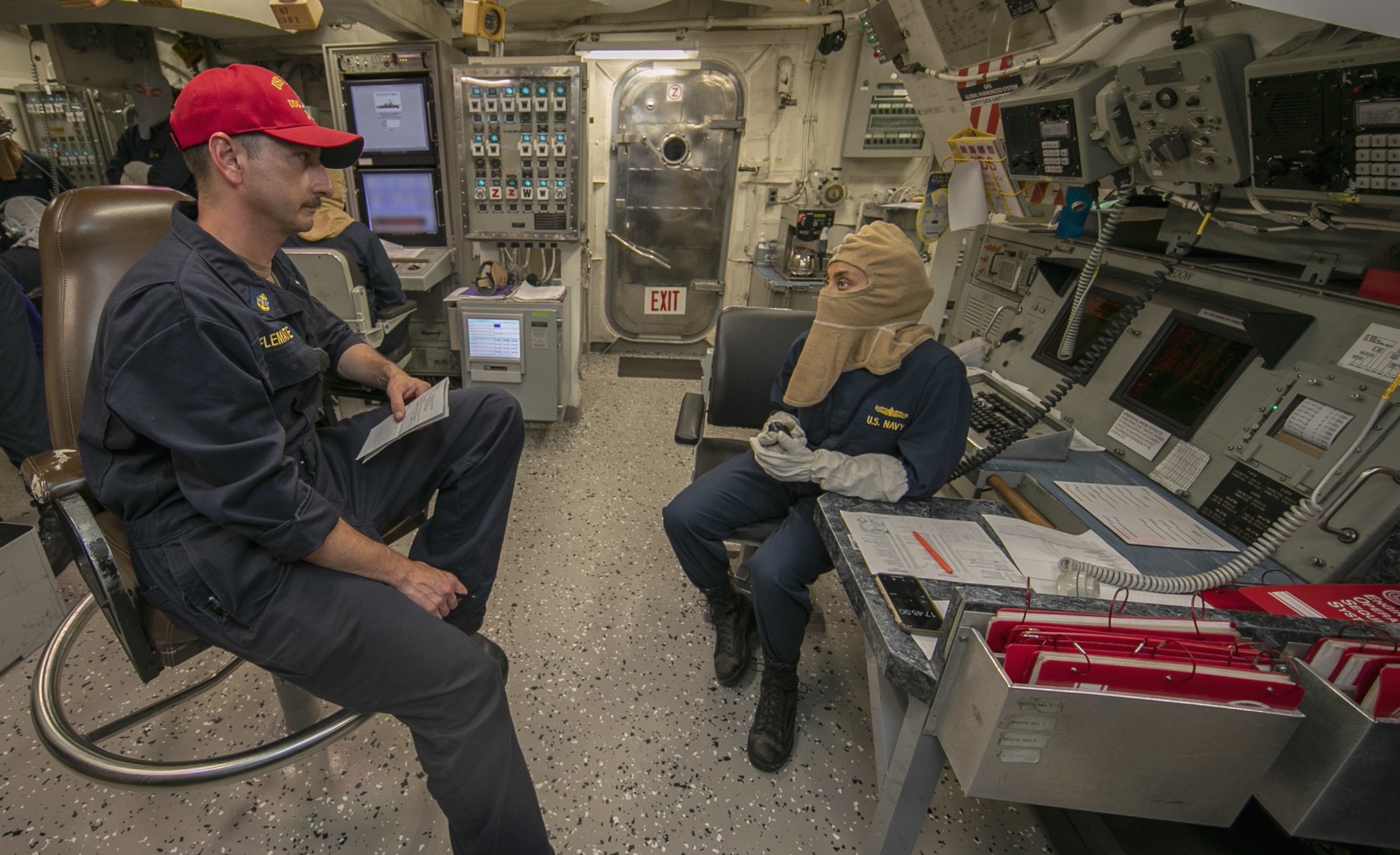 engineering department - Atlantic Ocean - June 2021  returning to Naval Station Mayport, Florida - June 2020  returning to Naval Station Mayport, Florida - June 2020  returning to Naval Station Mayport, Florida - June 2020 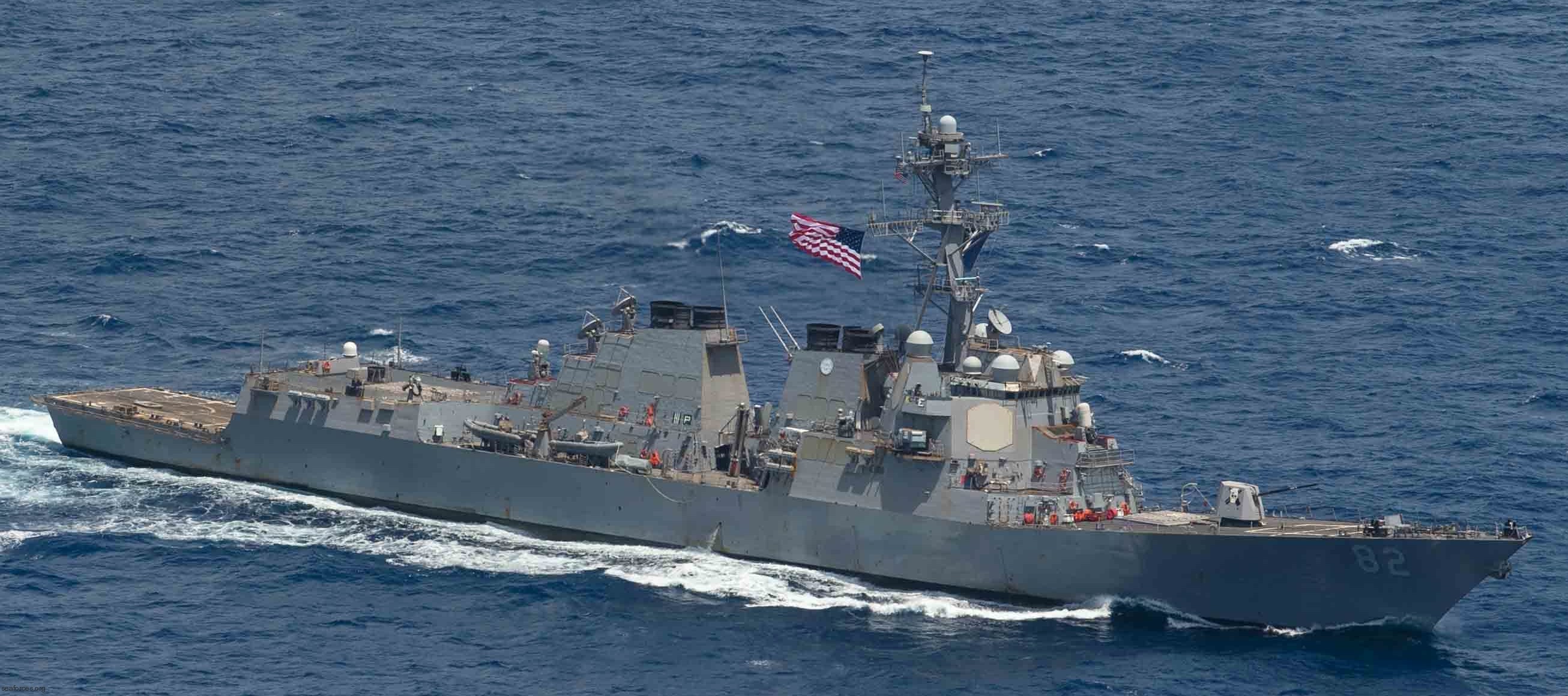 Caribbean Sea - May 2020  Arabian Sea - March 2020  Arabian Sea - February 2020  Arabian Sea - December 2019 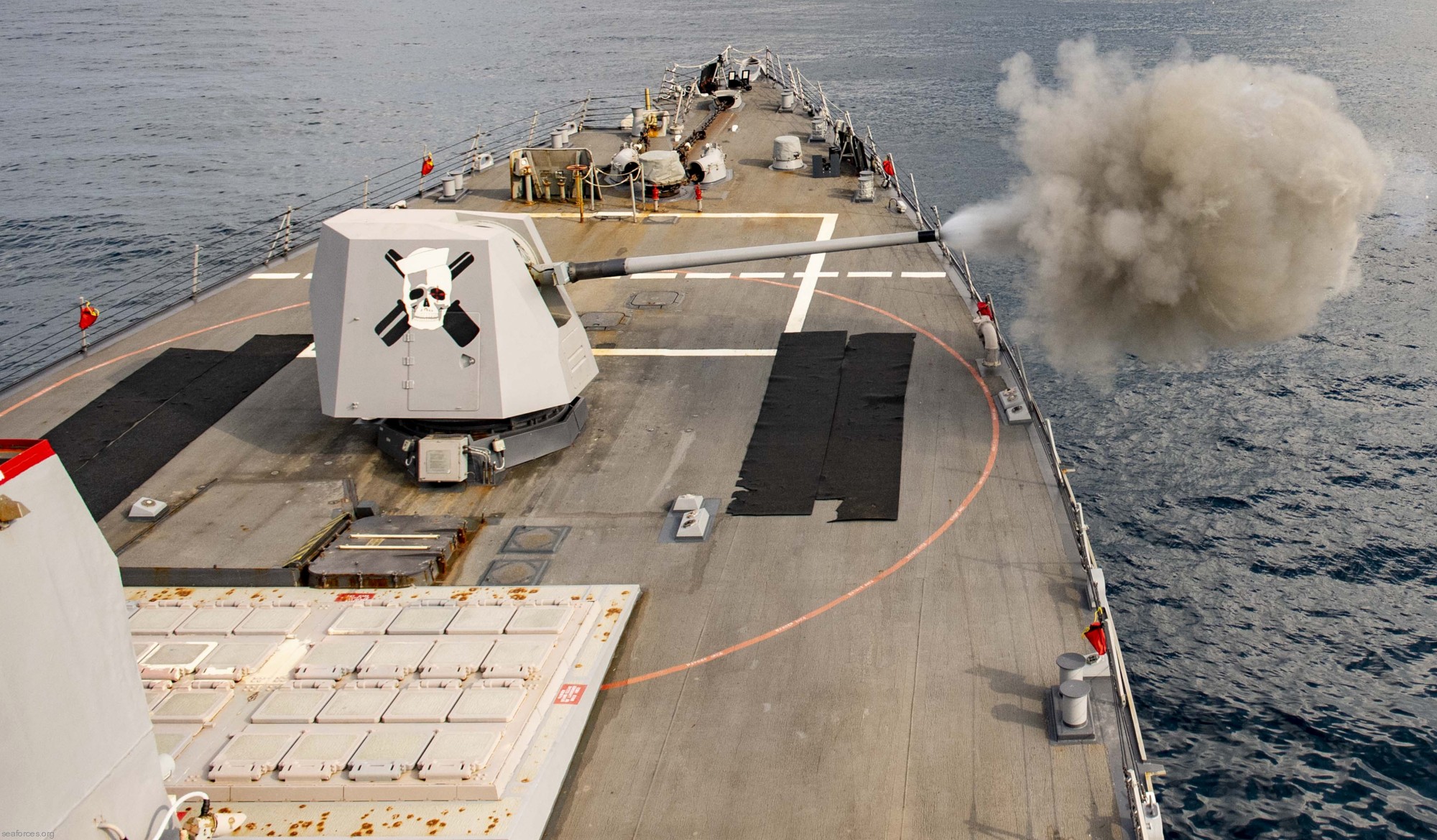 Mk.45 Mod.4 (5"/62-caliber) gun fire exercise - Gulf of Oman - November 2019  Arabian Sea - November 2019  Strait of Hormuz - October 2019  departing Naval Station Mayport, Florida - September 2019  departing Naval Station Mayport, Florida - September 2019  departing Naval Station Mayport, Florida - September 2019  departing Naval Station Mayport, Florida - September 2019  departing Naval Station Mayport, Florida - September 2019  Atlantic Ocean - August 2019  Atlantic Ocean - August 2019 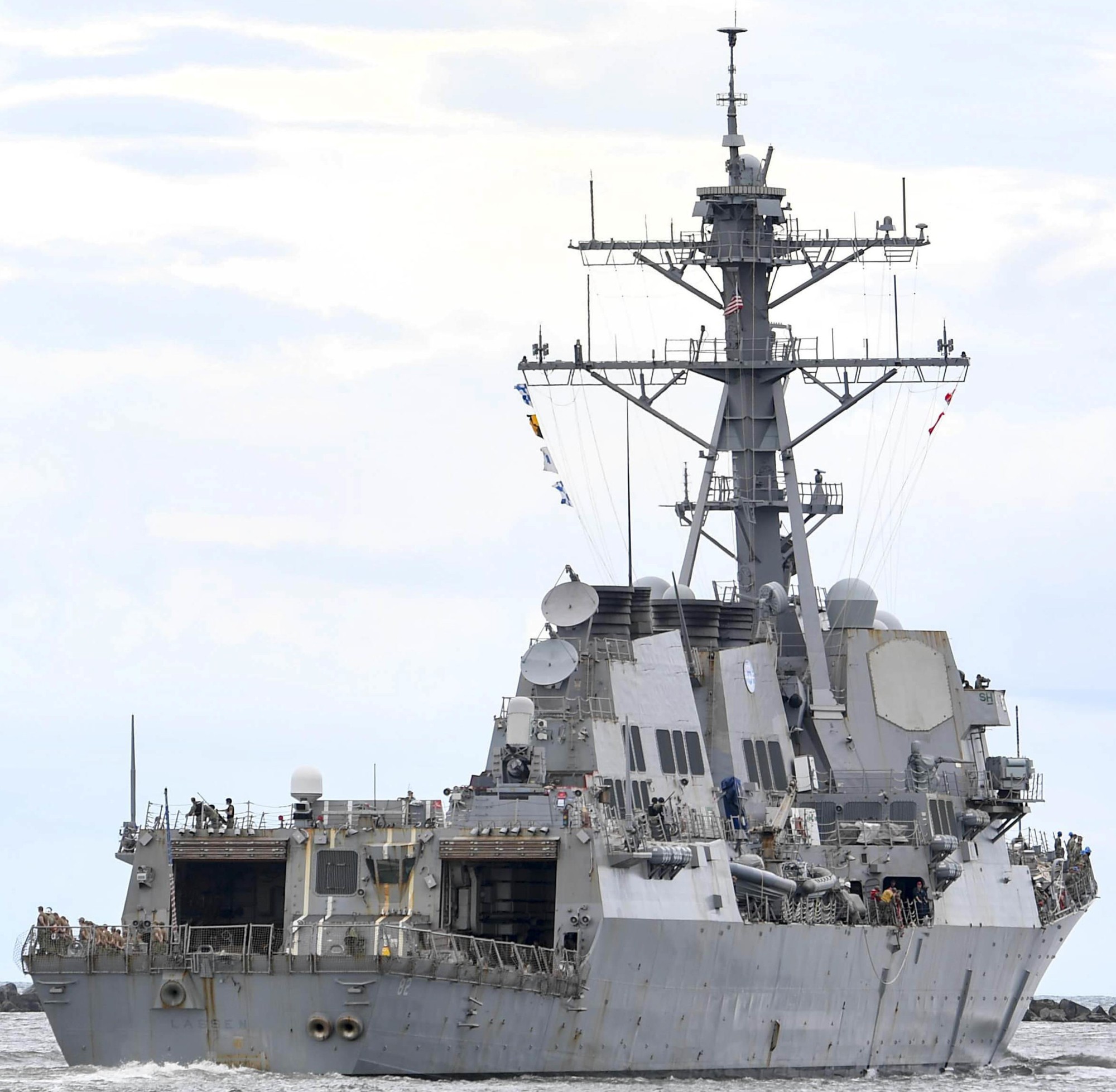 departing Naval Station Mayport, Florida ahead of Hurricane Dorian - August 2019  departing Naval Station Mayport, Florida ahead of Hurricane Dorian - August 2019  Atlantic Ocean - July 2019  Atlantic Ocean - July 2019  Atlantic Ocean - July 2019  Naval Station Mayport, Florida - May 2019  Mk.45 Mod.4 (5"/62-caliber) gun fire exercise - Atlantic Ocean - April 2019  departing Naval Station Mayport, Florida - April 2019  Mk.38 Mod.2 25mm machine gun live fire exercise - Atlantic Ocean - March 2019  Naval Station Mayport, Florida - March 2019  Newport, Rhode Island - September 2018  Fleet Week New York - May 2017 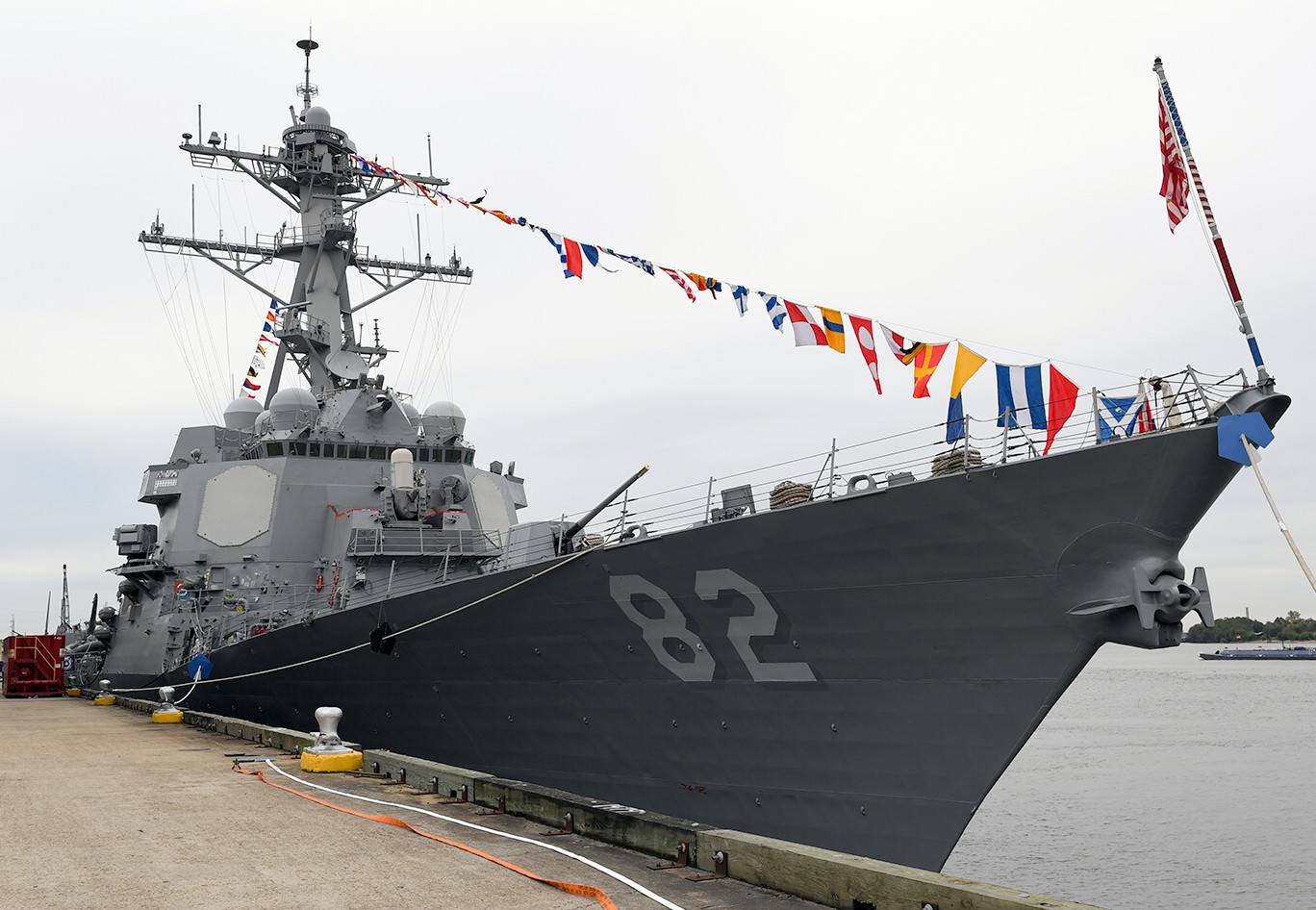 New Orleans, Louisiana - November 2016  an US Army UH-60 Blackhawk on the flight deck - Caribbean Sea - April 2016 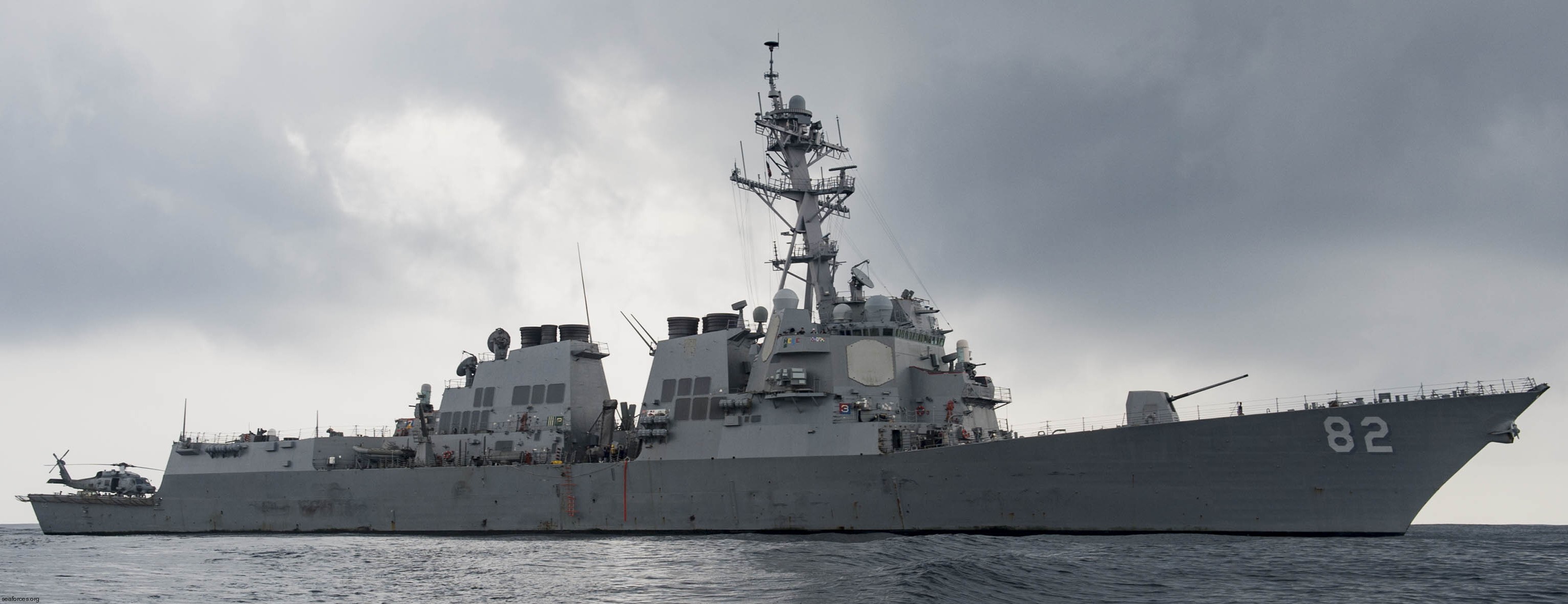 Pacific Ocean - April 2016  Mk.45 Mod.4 (5"/62-caliber) gun fire exercise - Pacific Ocean - April 2016  Mk.15 Phalanx close-in weapon system (CIWS) live fire exercise - Pacific Ocean - April 2016  Mk.15 Phalanx close-in weapon system (CIWS) live fire exercise - Pacific Ocean - March 2016  Pacific Ocean - February 2016  departing Fleet Activities Yokosuka, Japan - January 2016  departing Fleet Activities Yokosuka, Japan - January 2016 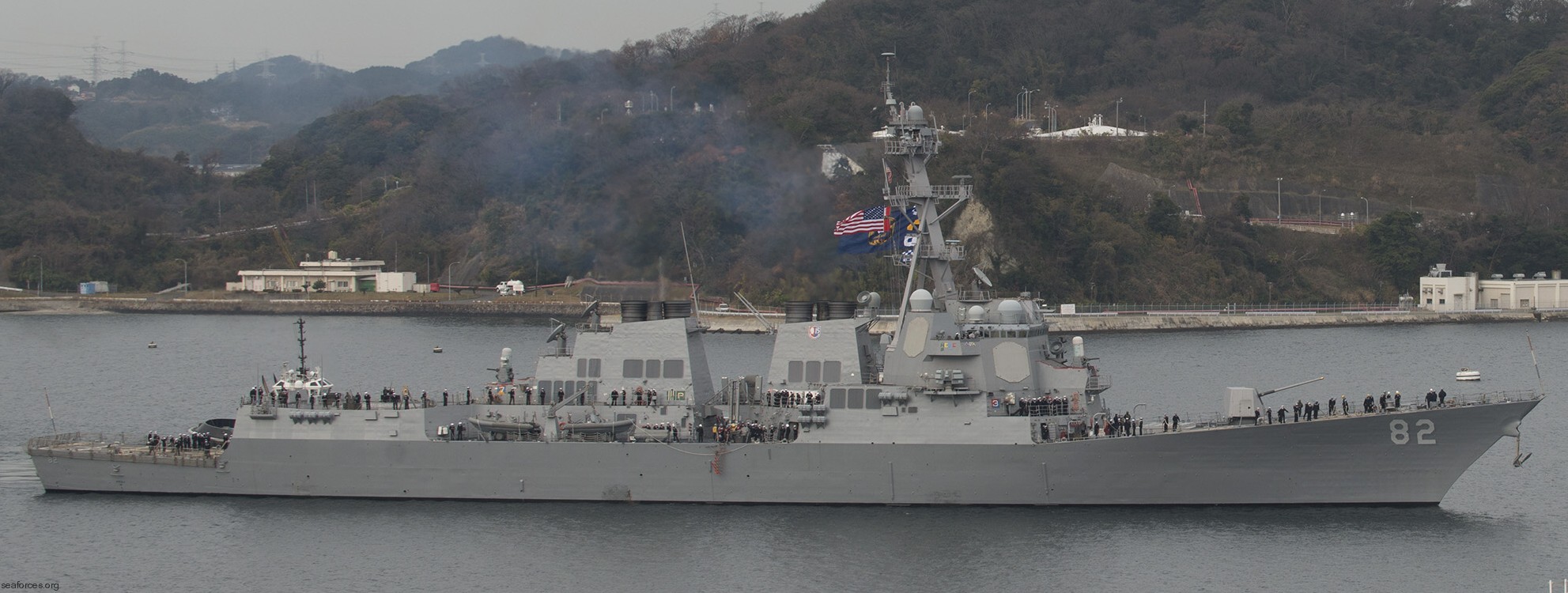 departing Fleet Activities Yokosuka, Japan - January 2016  departing Fleet Activities Yokosuka, Japan - January 2016  a missile canister was loaded into the forward Mk.41 vertical launching system (VLS) - Yokosuka, Japan - November 2015  a missile canister was loaded into the forward Mk.41 vertical launching system (VLS) - Yokosuka, Japan - November 2015  torpedo weapon-exchange - Fleet Activities Yokosuka, Japan - November 2015  South China Sea - November 2015  South China Sea - November 2015  Mk.15 Phalanx close-in weapon system (CIWS) live fire exercise - South China Sea - September 2015  sailors handling a Mk.54 torpedo - Pacific Ocean - September 2015  off Korea - May 2015  off Korea - March 2015  a BGM-109 Tomahawk land attack missile (TLAM) was launched from the aft Mk.41 VLS during exercise Multi Sail 15 - Pacific Ocean - March 2015  a Mk.54 torpedo was launched from the Mk.32 torpedo tubes - off Guam - March 2015  East China Sea - February 2015  during exercise Talisman Saber - Pacific Ocean - July 2013  during exercise Talisman Saber - Pacific Ocean - July 2013  Pacific Ocean - July 2013  USS Lassen launches a Standard Missile SM-2 from her forward Mk.41 VLS during exercise Multi Sail 13 - April 2013  ship's helm - Sea of Japan - March 2013  Otaru, Japan - February 2013 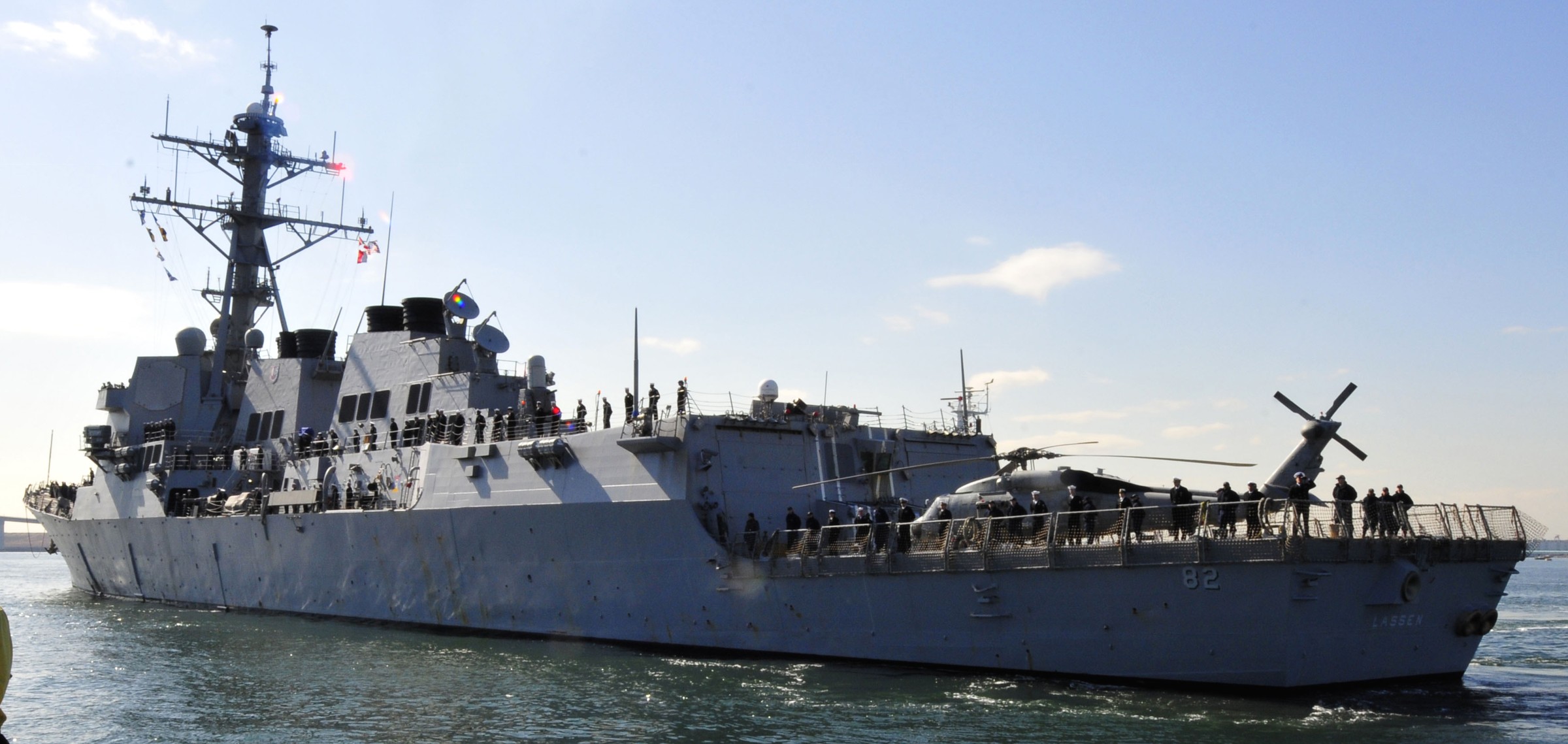 Tokyo, Japan - February 2012  Laem Chabang Port, Thailand - November 2011  a RUR-5 ASROC (anti-submarine rocket) was launched from the aft Mk.41 VLS - Pacific Ocean - June 2011  BQM-74E drones prepared for launching from the flight deck during exercise Valiant Shield - September 2010  A BQM-74E drone prepared for launch from the flight deck during exercise Valiant Shield - September 2010  A BQM-74E drone prepared for launch from the flight deck during exercise Valiant Shield - September 2010  A BQM-74E drone launches from the flight deck during exercise Valiant Shield - September 2010  moored at Fleet Activities Yokosuka, Japan - December 2009  Da Nang, Vietnam - November 2009  in dry dock at Fleet Activities Yokosuka, Japan - April 2009  in dry dock at Fleet Activities Yokosuka, Japan - March 2009  a missile canister was loaded into the forward Mk.41 vertical launching system (VLS) - Yokosuka, Japan - September 2007  Fleet Activities Yokosuka, Japan - August 2007  in dry dock at Fleet Activities Yokosuka, Japan - January 2007  Fleet Activities Yokosuka, Japan - September 2005  Fleet Activities Yokosuka, Japan - September 2005  Philippine Sea - June 2003 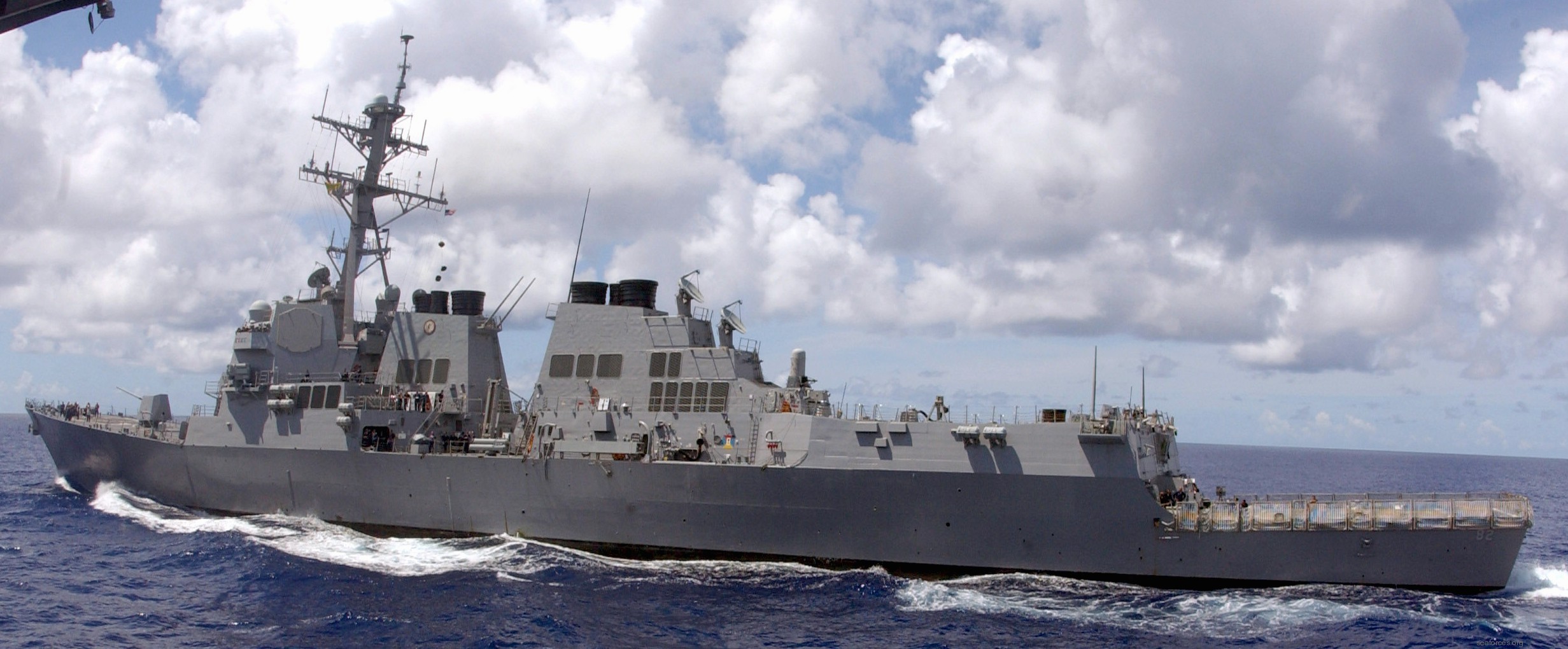 Philippine Sea - June 2003  Philippine Sea - June 2003  Pacific Ocean - February 2003  Pacific Ocean - February 2003  San Diego, California - January 2003  builder's trials  trials - December 2000  trials - December 2000  trials - December 2000  trials - December 2000  trials - December 2000  trials - December 2000  trials - December 2000  floating ceremony at Ingalls Shipbuilding, Pascagoula, Mississippi - October 15, 1999  floating ceremony at Ingalls Shipbuilding, Pascagoula, Mississippi - October 15, 1999 |
||
|
USS Lassen (DDG
82): USS Lassen was homeported in San Diego until she shifted homeport to Yokosuka Naval Base in Yokosuka, Japan in August 2005. On 15 February 2009 at 12:25 pm, Lassen collided with a Japanese 14-ton pleasure boat in Yokosuka harbor. On 23 March 2009 the Japan Coast Guard filed a case against both the destroyer's and the fishing boat's captains with local prosecutors for professional negligence that endangered traffic. On 1 July 2009, Fox News Channel reported that Lassen was tracking the North Korean ship Kang Nam 1, suspected of carrying contraband. On 27 October 2015 Lassen navigated within 12 nautical miles of Subi Reef, one of seven artificial islands built up by China in the Spratly Islands (commonly called the "Great Wall of Sand") in the past year, the first in a planned series of Freedom of navigation operations (also referred to as FONOPs). This is the first time since 2012 that the US has directly challenged China's claims of the island's territorial limit. In January 2016, she moved to Naval Station Mayport in Mayport, Florida. According to the Standard Navy Distribution List, March 2016, at that time she was assigned to the new Naval Surface Squadron 14. |
||
|
Commander Clyde Everett Lassen (March 14, 1942 - April 1,
1994): Clyde Everett Lassen, a native of Fort Myers, Florida, earned the Congressional Medal of Honor for his courageous rescue of two downed aviators while commander of a search and rescue helicopter in Vietnam. As the UH-2 Seasprite helicopter hovered over the water, its crew listened intently on their earphones for a message from the coastline. Some where beyond the pitch-dark horizon were two naval aviators whose plane had been shot down deep in North Vietnamese territory. Their exact position was not known. No one knew even if they were still alive. They had not yet made contact with any other rescue aircraft in the area. There was nothing the helicopter crew could do but wait and listen as they had done since leaving their ship shortly after midnight some time earlier. Flying the single-engine UH-2 was 27 year old Lieutenant (then LTJG) Clyde E. Lassen, Officer in charge of the helo detachment aboard the guided missile frigate USS Preble (DLG 15). To his right sat Lieutenant (jg) Clarence L. Cook, his copilot, and behind them, his two crewmen, Aviation Electrician’s Mate 2nd Class Bruce B. Dallas, and Aviation Machinist’s Mate 3rd Class Donald N. West. They waited. Seconds became minutes. Finally, voice communication was established. The downed aviators reported they were sitting on the side of a steep, heavily wooded hill surrounded by tall trees, thick undergrowth, and an undetermined number of enemy troops. Conditions clearly called for a helicopter, and fast. By the time the message was completed, LTJG Cook had located the hillside position on his plotting map. He then gave LT Lassen the course to follow and, while the pilot pressed the UH-2 over the coast into the enemy land, kept him informed on the layout of the countryside below. The overcast sky made the terrain shadowless. Ground objects were almost indistinguishable when the copter arrived in the search area. At first there were no signs of the survivors. But, after circling in darkness a few times, the SAR crew sighted the flash of flare pistols and the beam from a rescue strobe light. Lieutenant Lassen swung the helo toward the illumination and moved in to survey a probable landing site. A likely spot, he judged, was a rice paddy at the bottom of the hill, about 200 feet from the downed airmen. He could hover over the clearing long enough for them to make it to the helo, despite the enemy. That was his plan. And it might have work - and the whole ordeal would probably have been over in a matter of seconds. But what looked like a quick and simple rescue turned out instead to be a real cliff-hanger. One worthy of an entry in the Medal of Honor ledger. After directing the aviators to make their way down the hill to the rice paddy, the lieutenant commenced a partial hover just high enough to keep his helo from sinking in the mud. This drew the enemy’s attention and they started pouring in small arms and automatic weapons fire. Petty Officers Dallas and West sighted on the muzzle blasts and returned the fire with the airship’s two door-mounted M-60 machine guns. Meanwhile, the downed aviators reported over their rescue transmitters that they were unable to make it through the undergrowth. LT Lassen decided to pull up out of gun range to evaluate the situation a little further and study another approach. Like most helo pilots in the combat zone, he was relying on limited experience. He had been flying only a little more than two years. Nonetheless, he was no newcomer to naval aviation. Before he earned his wings through the Naval Aviation Cadet program, he served with the fleet for almost three years, attaining the rate of aviation electronics technician 3rd class. He had met each challenge with success. Now he was about to make another decision from which there could be no return. The LT called for a rescue aircraft nearby to move into the area and illuminate the survivors location with flares. They he worked the UH-2 farther up the hill toward the airmen and located a probable landing spot between two large trees. There, Dallas and West lowered a rescue hoist, which the airmen could reach. Just as rescue appeared a sure thing, the last of the overhead flares went out. Depth perception was lost momentarily and the helo veered slightly to the right. One of the crewmen yelled that they were going to hit one of the trees. A sharp jolt went through the helo and it pitched nose down into a right turn. Instinctively, LT Lassen righted the aircraft and climbed clear of the foliage. No one was hurt, but the UH-2 had suffered serious damage. It was vibrating almost uncontrollably. Things couldn’t be much worse. His fuel was dangerously low. His aircraft was badly damaged. And, he was drawing fire from every enemy gun within range. On top of this, he and the other rescue aircraft had run out of overhead flares. They were strictly in the dark. A further rescue attempt seemed hopeless. But as far as LT Lassen was concerned, he hadn’t completed his mission, and he was determined to do so, successfully. Again he sized up the situation, called for more flares and, for the second time, told the downed aviators to descend the hill and meet him at the rice paddy. As skipper, he was confident Dallas and West could suppress the enemy gunners with their M-60’s until the flares arrived. But he had no desire to go another round in the dark with those skyscraping trees. He had enough of them. Following the pilot’s instructions, the two men on the ground attempted once more to work their way through the underbrush toward their rescuers appointed position. The delay, thus far, had allowed more enemy to arrive on the hill. The helo, in order to cover the aviators’ descent, had to stay close by. This need for close-quarter maneuvering made it nearly impossible for support from the other air rescue units to be effective against the communist force. As things stood, the airmen’s safety rested primarily on the accuracy of LT Lassen’s gunners and his ability to fly his crippled aircraft, both talents which had proven unequalled. Before long, the additional flares arrived and the sky was again lighted, aiding the lieutenant’s second approach to the paddy. The enemy kept the airmen pinned down at the spot where LT Lassen could not reach. This complicated matters even more, because time suddenly became a crucial concern. Only 30 minutes of fuel remained in the helo’s tanks, and both he and LTJG Cook were aware of the distance through enemy territory that lay between them and friendly hands. There might be enough time for one more attempt. No more. The Lieutenant called for another flare drop and commenced his final rescue attempt. For a moment the sky was bright like high noon. But, just when the helo reached an altitude of about 50 feet over the rice paddy, the flare went out. There was nothing but darkness. Luck, never of the best in this episode, had seemed to run out. With no time to wait for another flare drop, the young pilot went for broke and turned on his landing lights so he could see to set down. This withdrew the enemy’s concentration on the two airmen, who unhesitatingly cleared the brush and dashed toward the lights. In a hail of lead, the copter crew pulled the two-some on board as the pilot lifted his vibrating, bullet-riddled chopper into the darkness, out of harm’s way. A thimble of fuel was in the helo’s tanks as the SAR crew headed toward the sea. En route, LT Lassen’s evasive ability was again put to the test when he had to outmanoeuvre a last effort by the enemy to knock him out of the sky with antiaircraft fire. By the time he reached the water and set down on the helo pad of the guided missile frigate USS Jouett (DLG 29), there was scarcely more than five minutes flight time remaining in the helicopter’s fuel lines. The account of the rescue was logged as a successful, routine SAR mission. But at NAS Atsugi, home base for Helicopter Combat Squadron Seven, the rescue flight of 19 June 1968 will be acclaimed as one of the most daring feats of flying to come out of the Vietnam Conflict. LT Clyde E. Lassen became the first naval aviator and fifth Navyman to be awarded the Medal of Honor for bravery in Vietnam. His copilot, LTJG Cook, was awarded the Navy Cross for his gallant part played in the rescue. The two crewmen, Petty Officers West and Dallas, were awarded Silver Stars. (The previous section was written by - Marc Whetstone, Chief Journalist, USN.) Duty Stations: Helicopter Combat Support Squadron One / Aviator Helicopter Combat Support Squadron One, Detachment Atsugi / Maintenance Control Officer Helicopter Combat Support Squadron Seven / Officer in Charge, SAR DET Decorations and Medals: Air Medal (First Strike/Flight Award) Presidential Unit Citation - awarded Delta River Patrol Group (Task Group 116.1) Good Conduct National Defense Service Medal Vietnam Service Medal with four bronze stars Vietnam Campaign Medal with Device Medal of Honor citation: CLYDE EVERETT LASSEN Lieutenant, United States Navy Helicopter Squadron 7, Detachment 104 Embarked on USS PREBLE, Republic of Vietnam 19 June 1968 CITATION: "For conspicuous gallantry and intrepidity at the risk of his life above and beyond the call of duty as pilot and aircraft commander of a search and rescue helicopter, attached to Helicopter Support Squadron 7, during operations against enemy forces in North Vietnam. Launched shortly after midnight to attempt the rescue of 2 downed aviators. Lt. (then Lt.(jg.)) Lassen skillfully piloted his aircraft over unknown and hostile terrain to a steep, tree-covered hill on which the survivors had been located. Although enemy fire was being directed at the helicopter, he initially landed in a clear area near the base of the hill, but, due to the dense undergrowth, the survivors could not reach the helicopter. With the aid of flare illumination, Lt. Lassen successfully accomplished a hover between 2 trees at the survivors' position. Illumination was abruptly lost as the last of the flares were expended, and the helicopter collided with a tree, commencing a sharp descent. Expertly righting his aircraft and maneuvering clear, Lt. Lassen remained in the area, determined to make another rescue attempt, and encouraged the downed aviators while awaiting resumption of flare illumination. After another unsuccessful, illuminated rescue attempt. and with his fuel dangerously low and his aircraft significantly damaged, he launched again and commenced another approach in the face of the continuing enemy opposition. When flare illumination was again lost, Lt. Lassen, fully aware of the dangers in clearly revealing his position to the enemy, turned on his landing lights and completed the landing. On this attempt, the survivors were able to make their way to the helicopter. In route to the coast he encountered and successfully evaded additional hostile antiaircraft fire and, with fuel for only minutes of flight remaining, landed safely aboard U.S.S. Jouett (DLG-29). Lt. Lassen's extraordinary heroism at the risk of his life, above and beyond the call of duty, are in keeping with the highest traditions of the military service and reflect great credit upon himself, his unit, and the U.S. Navy." The medal was officially presented 16 January 1969.
|
||
| patches + more | ||
    |
||
|
|
seaforces.org |
USN ships
start page | |

